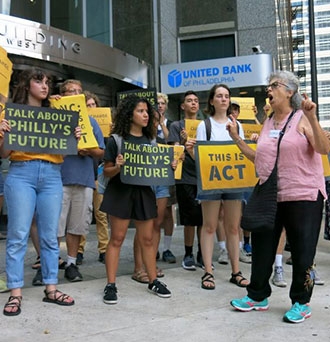
In the battleground state of Pennsylvania, voters prioritizing environmental issues may have tipped the scales of the election in favor of Joe Biden.
The Environmental Voter Project records that at least 54,976 environmentalists cast their ballots for the very first time in the presidential election. That number surpasses the margin of victory between the two major presidential candidates in Pennsylvania as of Tuesday afternoon, when Biden was leading by about 45,400 votes.
The 2020 general election has been notable for its record voter turnout overall: 62% of the eligible voting population in the United States, as of Sunday’s tabulations.
Environmentalists — people who say they view climate and the environment as a top priority — haven’t always been good at showing up to the polls.
“Environmentalists are very bad at voting,” Grist’s Eve Andrews wrote in 2018. She cited the 2014 midterm election as an example: In it, 44% of all registered voters showed up, but only 21% of registered voters who considered themselves environmentalists did.
That’s what Nathaniel Stinnett, co-founder of the Environmental Voter Project, hopes to change. “We’re not in the mind-changing business; we are solely in the behavior-changing business,” he told WHYY News.
The Environmental Voter Project maintains a database of voters who it considers likely to prioritize environmental issues, based on polling and modeling, but who most of the time don’t vote. Then it starts pushing those voters to the polls via text message, calls, door-to-door canvassing, and more.
Those involved in the effort don’t talk about policies, or try to convince non-environmentalists on the issues … they’re “just laser-focused on turning them into better voters,” Stinnett said. “And that’s not just the big sexy elections like the presidential [ones]; we use local and state and special elections as behavioral intervention opportunities to start changing these people’s voting habits.”
And this election season, it was effective: The Environmental Voter Project’s messaging mobilized 8,845 early voters in the city of Philadelphia, with 28,441 early voters in the broader Philadelphia area (Philadelphia, Bucks, Chester, Delaware and Montgomery counties).
Other environmental groups worked to increase turnout as well. The Sunrise Movement, a youth-led organization mobilizing around climate action, claims a major impact on youth turnout in the Nov. 3 election, reaching an estimated 3.5 million across the country. (For context, when the race was called Saturday, Biden led the popular vote by a margin of more than 4 million). NextGen America, backed by billionaire climate activist Tom Steyer, dedicated $45 million to mobilizing young voters, as well.
That doesn’t mean all environmentalists cast votes for Biden, of course; the Election Voter Project encourages people to vote, but doesn’t tell those people who to vote for. And the Sunrise Movement, although instrumental in shifting Biden’s environmental action plan, did stop short of an official endorsement. But given the current president’s climate policy record, it’s likely that voters looking for environmental protection may have leaned Democrat in the general election.
Who are environmentalist voters, anyway?
To some, it might seem counterintuitive that environmentalists — typed as aggressively vocal and often politically minded — would ever fail to turn out on Election Day. But that’s, in part, because the typical environmentalist may not fit an assumed stereotype.
Demographically, the Environmental Voter Project’s targeted voters in Philadelphia were twice as likely to be Black than white. They were also more likely to be young than old, women than men, and more likely to make less than $50,000 a year than to exceed that number.
“In every state that the Environmental Voter Project works in, we find that young people are more likely than older people to care deeply about climate and the environment … women are more likely than men, and people of color, especially African Americans and Asian Americans in Pennsylvania, are more likely than white people to talk about climate and environment as their top priority,” Stinnett said.
In the suburbs, “it’s the same, but the differences are not as stark,” he added. That’s usually because the numbers are smaller; the Environmental Voter Project is less likely to find people making salaries of under $50,000 living in Montgomery County, for example.
Those differences in demographics are telling. People of color and low-income communities in the United States are much more likely to be impacted by toxic air and polluted water — it can cause life-altering illnesses via chemical exposure, or put residents at higher risk for other health hazards like COVID-19. For those communities, environmental protection against the climate crisis isn’t just an ideal — it’s an urgent and necessary goal for their survival.
At the same time, those communities are also less likely to vote, due to barriers such as busy lives, illness, transportation, candidate disinterest, and administrative issues, as well as larger systems of voter suppression and disenfranchisement.
But this fall, many of them did make it out to vote, and now, they might be in a position to demand that their priorities be reflected by the actions of elected officials.
